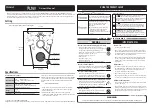
Welch Allyn MicroTymp® 4 Tympanometer User Manual
DIR 80024157 Ver A
Page x
Do not immerse the unit in any fluids. See the Routine Maintenance Section of this manual for
the proper cleaning procedure for the instrument and its accessories and the function of single-
use parts.
Do not use the instrument in an oxygen-rich environment or in the presence of a flammable
anesthetic mixture or other flammable agents.
Thermal paper printouts fade with exposure to light or heat. Photocopying the patient record
test results will ensure a more permanent record is kept.
Do not drop or otherwise impact this instrument. If the instrument is dropped or damaged, return
it to the manufacturer for repair and/or calibration. Do not use the instrument if any damage is
suspected.
The instrument must be stored and used indoors within the specified temperature, pressure and
humidity ranges.
As with all instruments of this nature the measurements taken will be influenced by significant
changes in elevation and pressure. See Daily Check section for more information.
Do not attempt to open, modify or service the instrument. Return the instrument to the
manufacturer or distributor for all repair and servicing requirements. Opening the instrument
will void the warranty.
This instrument contains a rechargeable Nickel-Metal Hydride (NiMH) battery-pack. The battery
is not intended to be changed by the user. Batteries may explode or cause burns, if disassembled,
crushed or exposed to fire or high temperatures. Do not short-circuit.
E
LECTROMAGNETIC COMPATIBILITY
(EMC)
CONSIDERATIONS
Medical electrical equipment needs special precautions regarding EMC and needs to be installed
and put into service according to the EMC information in the Appendix. This provides guidance
on the electromagnetic environment in which to operate the instrument.
Portable and mobile radio-frequency (RF) communications equipment can affect medical
electrical equipment. The instrument should not be used adjacent to or stacked with other
equipment; if this is unavoidable the instrument should be observed to verify normal operation.













































